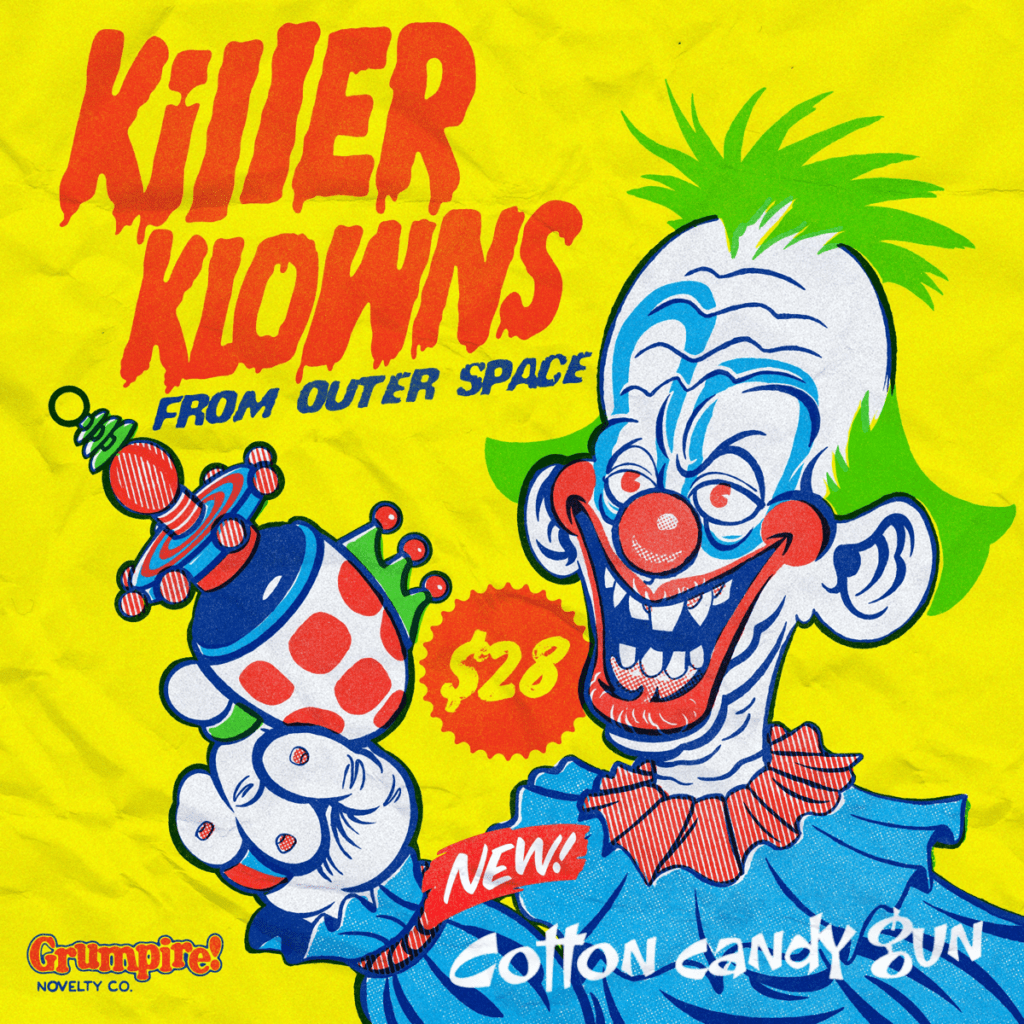“PT Barnum said it so long ago
there’s one born every minute, don’t you know”
– The Dickies
Editor’s note: Originally this article was going to be a true-to-life Piss-Take. I have spent several adult years thinking those exact words sung by Dickies vocalist Leonard Graves Phillips apply perfectly to fans of Killer Klowns From Outer Space, puzzled by how this revoltingly daft film could have acquired such a devoted following. It seems to embody every characteristic I find cringe-worthy in horror: corny jokes, bad dialogue, obnoxious characters, annoyingly ridiculous plot. Any of those things can be endearing if done right, but Killer Klowns? Nah. I hungrily thought, “Yes! I am going to take this movie down!” while planning my spooky season writing material, and with gleeful dismay, I set out to rewatch Killer Klowns for the first time in over a decade. But…well, it almost pains me to say I had somewhat of a different reaction this time. as you will see momentarily. – LB
In its title, Killer Klowns From Outer Space tells us exactly what we’re getting. Among other proclamations, this is a title that says “sophisticates need not apply.” Despite its popularity today, upon its release in 1988 it just wasn’t the kind of movie that was sent to proper film critics for review. Try and find an original write-up on Killer Klowns and, other than a blurb in the TV Guide, Google generates a sea of tumbleweeds. Sure, Johnny Clownface at Nostalgia Horror Weekly loves this movie, but what insights could Pauline Kael have had to offer about the Chiodo Brothers’ alien carnival nightmare in 1988? Perhaps fortunately we’ll never know.
But a lack of accredited reviews didn’t stop cable television from turning Killer Klowns into (for better or worse) a classic. And really, late ‘80s cable is the only suitable place for a high-concept, genre-bending sci-fi horror piece that never totally lives up to the potential it promises. That home in cable ~ in a seemingly endless rotation ~ turned an entire generation of adolescents on to kitschy, obnoxious horror filmmaking in an almost manufactured way. To use the movie’s metaphor, America’s sweet, unspoiled youth, haplessly cocooned and festering in cotton candy, came out the other side as a new crop of monster kids.
Of course, there’s nothing wrong with that. Except, maybe a little bit there is. In terms of personal identity and further, brand imaging, an argument can be made that smaller is better. This is something I’ve considered more closely lately, especially in relation to social media use. Keeping our identities small involves a constant evaluation of ourselves. Conceptually, we should view our identities as works in progress as we re-evaluate our personal interests and goals, adding and deleting to prioritize how we think of, and how we want to present ourselves. It’s a sharpening of the blade so to speak. A lot has been said (and will continue to be said) about the toxicity of the horror community, and we can’t be afraid to address the potential issues that occur when a significant enough portion of horror fans use their fandom as a main ingredient in forming their identities. “Halloween Every Day” is decidedly personal brand imaging and can be harmless on its own, but when Spirit Halloween stores open up every year and fans figuratively make mad Black Friday-like dashes to get their hands on something like an officially licensed Killer Klowns Cotton Candy Gun™, the innocent fun of it shifts a bit toward a vain attempt at gaining some kind of social status. That’s where we enter the dangerous, potentially toxic territory; positioning our interests as the first factor in the makeup of our identities can lead to unnecessary personal battles (external and internal) about things that are ultimately subjective and therefore kind of trivial. We begin to rely on the material rather than the ideological, which sets us up for defensive posturing. This of course extends beyond the horror community into all areas of human interest, and by continuing to let our hobbies and/or preoccupations dominate us, we’re not doing our part in productive self-evaluation.
Keeping that in check can be a hard task for some, especially with how socially important a novelty possession like the Cotton Candy Gun™ seems. Appearing in multitudes of Twitter and Instagram users’ posts, that mass-marketed colorful clown toy became a status symbol, not just in a “IYKYK” situation, but a “I’m a true fan because I got it first” thing. Am I picking on Killer Klowns here, given the hundreds of coveted novelty items linked to other popular horror fares? Yeah, I am. And really that’s just because Killer Klowns is such a bad movie.
But Elbee, you said this wasn’t a Piss-Take!
It’s true, this isn’t. Not fully, anyway. No matter how much any of us might enjoy Killer Klowns, we have to admit it’s not particularly good. Yes, “good” is subjective, but again, when we keep our identities small, we’re able to speak about these topics with more of an open mind (so calm down). I say Killer Klowns is bad not because it isn’t fun or because it doesn’t have heart thrown into it. It is merely what the film promises that it doesn’t deliver that makes it a disappointment. The film attempts to subvert tropes of alien invasion movies of yore (Invasion of the Body Snatchers, Invaders From Mars) by turning the science into even more ridiculous fiction. Two young adults are necking in the back of a truck on lovers’ lane when a strange-looking object flies across the sky. They go to investigate, and instead of finding a meteorite after chasing the shooting star, they find a fully lit circus tent. Inside are colorful passageways filled with traditional clowning gags that serve no ostensible purpose other than familiarity for the viewer ~ that is, until the kids wander into the room full of absurd bright pink cotton candy cocoons and are exposed to the Klowns’ sinister plot. The rest of the film spends equal time following the kids as they try to save their town with absolutely no kind of plan whatsoever and following the hideous-looking Klowns as they hide inside pizza boxes and knock things off shelves in a drug store for no discernable reason.
On paper, all that really does sound cool. And visually stimulating! Horror that doesn’t shy away from the ridiculous is often the most enjoyable. But Killer Klowns doesn’t do enough of a job developing its ridiculousness. What exactly is the Klowns’ sinister plot? To kill all humans? I guess. But why? Does it matter? Some may say no, but I would argue that it does. In order to be truly subversive, a clear narrative and basis of subversion must be presented. “Evil clown aliens kill people in stupid ways” isn’t enough. Thematic elements in genre filmmaking don’t have to be one hundred percent sophisticated, but Killer Klowns doesn’t offer us much subtext as far as what the Klowns want — not even a cliched underlying “humans aren’t being good stewards of their planet so they all must die” type of thing. Of course, that theme is overused, but I’d take it as opposed to literally nothing! It is hinted that the Klowns are harvesting humans for food, but only barely as one of them drinks from a cocoon through a wacky curly straw — which translates onscreen as more of a silly shocking gag than a plot point. What we end up with is a film that is dully repetitive and suffers from a lack of development beyond the concept stage. Which is just so unfortunate because Killer Klowns is very high-concept. The pitch itself is so enticing it makes suckers out of us when we’re hooked. It’s a page from PT Barnum 101.
Before abandoning the case for subtext altogether though, it could be lightly argued that the film touches on a particular type of human element — that even the most dedicated police officers suffer from ineptitude. John Vernon’s character is a gruff old bigot who hides behind his badge, and he rightfully gets his comeuppance from one of the uglier Klowns in the movie. John Allen Nelson’s portrayal of the “good” cop is a bit more valiant until we see him stand by and just let a Klown massacre an entire group of people using a deadly shadow puppet dinosaur (one of the better visual gags in the film, actually). But before the movie goes too far into “F*** da police” territory, it’s reeled back by Nelson’s hero moment in which his character takes down the big boss giant mutant Klown basically just by hurling his police badge toward it. It’s mixed messaging to say the least.
But now, regardless of all its frustrating corniness and lack of development, and all the things I have to complain about horror fandom and assigning importance to objects and behavior that may be unhealthy, I do have to admit Killer Klowns is a pretty fun watch. My household does own an old DVD of the movie, so popping it in and checking out the special features on the disc inadvertently red-pilled me. Seeing the Chiodo Brothers’ home movies from when they were growing up, the simple monster movies they made in their basement and around their neighborhood, showed me the absolute heart that went into making Killer Klowns. The Chiodos wear their influences on their sleeves, owing all to greats like Ray Harryhausen and matinee-style monster movies of the past. Hearing them speak about it notes something more than prideful nostalgia, something that transcends branding and ego, something that is so genuine it makes me surrender to “every movie is a miracle.” Clearly, Killer Klowns was a passion project, and its success shouldn’t necessarily be taken lightly, no matter how accidental it feels.
Am I still annoyed by the marketing of the Cotton Candy Gun™? Of course. Am I even more annoyed a Killer Klowns video game (similar to the Friday the 13th one) has been announced? Ehhh, actually the property seems ripe for that. One thing I’ll never be annoyed by is the theme song, a delightful slice of pure carnival mayhem from The Dickies that acts as a band-aid for all the more irritating parts of the movie. I’m willing to sit through endless obnoxious bickering by the ice cream truck brothers and questionable corny jokes like “Gumbo the toothless elephant” and “Chief Running At The Mouth” just because this song exists. But most importantly, the Chiodos themselves have made me (somewhat) less of a snob about their film, and to stay true to re-evaluating my personal identity, that’s something I won’t argue. ★


